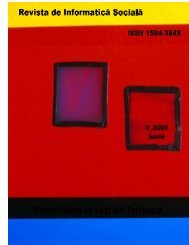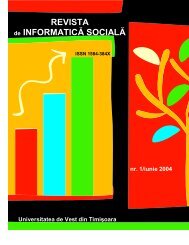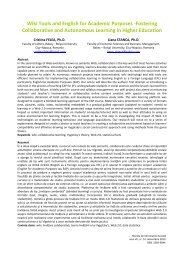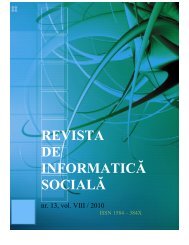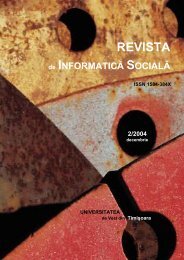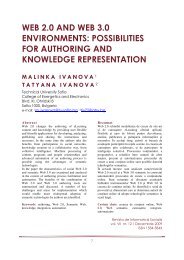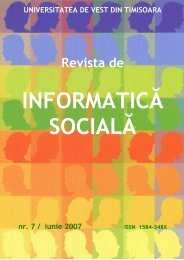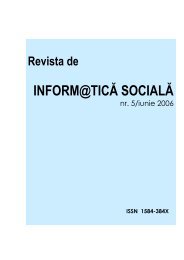THE TRANSITION FROM OLD TO NEW MEDIAThe <strong>de</strong>velopment and increasing diffusion <strong>of</strong> the Internet have led to a pr<strong>of</strong>ound transformation inthe sphere <strong>of</strong> communication. The whole mass media industry is currently facing the transition fromthe traditional broadcasting mo<strong>de</strong>l to a new “participatory culture” (Jenkins 2006a, 2006b) in whichany user is potentially given the power to make her personal contribution to the creation,distribution and consumption <strong>of</strong> new and original media content. The scope <strong>of</strong> change has all thecharacteristics <strong>of</strong> a real revolution.Being able to anticipate what could be the consequences, in the medium and long-term, that such aprocess <strong>of</strong> change will entail for our society is not among the easiest task, as John Naughton (2010)reminds us: “I’m writing this in 2010, which is seventeen years since the web went mainstream. IfI’m right about the net effecting a transformation in our communications environment comparableto that wrought by Gutenberg, then it’s patently absurd for me (or anyone else) to pretend to knowwhat its long-term impact will be. The honest answer is that we simply don’t know. The trouble is,though, that everybody affected by the net is <strong>de</strong>manding an answer right now”.Major changes in the evolution <strong>of</strong> communication technologies and in the transmission <strong>of</strong>knowledge surely can have <strong>de</strong>ep impact on a social, economic, cultural and cognitive level. We allknow that the introduction <strong>of</strong> the printing press was one <strong>of</strong> the major forces that <strong>de</strong>termined a series<strong>of</strong> long-term changes in politics, science, religion and culture, that finally contributed to give birthto what is commonly referred to as the mo<strong>de</strong>rn and capitalistic society (Weber 1905; Eisenstein,1979). The Internet will likely produce similar effects, even if we are not now in the position toanticipate the direction and magnitu<strong>de</strong> <strong>of</strong> these changes, as soon as they are still unfolding (Carr,2008; Castells, 2001).One <strong>of</strong> the things that we can do at present is trying to analyse more in <strong>de</strong>pth the trends that seemsto be consolidating, as far as the transition from old to new media is taking place. A specific focus<strong>of</strong> attention is related, in particular, to the attitu<strong>de</strong>s <strong>of</strong> younger generation, as they will likely be themain protagonists not only <strong>of</strong> this phase <strong>of</strong> transition, but also <strong>of</strong> the future <strong>of</strong> the Internet. In theinternational literature, a series <strong>of</strong> survey-based research and case studies are currently available(Lenhart et al., 2010; Ito et al., 2009; Ri<strong>de</strong>out et al., 2010; Smith et al., 2009), that seem tosomehow provi<strong>de</strong> supporting evi<strong>de</strong>nce to the thesis that teenagers and young adults today are moreand more connected to the web, and that a growing part <strong>of</strong> their social life actually is mediated by acomputer screen. In particular, youngsters are increasingly involved in social network sites likeFacebook and MySpace (Boyd, 2008), in the creation <strong>of</strong> blogs, in producing and sharing new audiovi<strong>de</strong>omaterial on sites such as YouTube and Vimeo, and in general in all that complex <strong>of</strong> activities<strong>of</strong> social networking, bookmarking and sharing that is part <strong>of</strong> the so-called Web 2.0 (O’Reilly,2005). At the same time, they tend to gradually move away from traditional media (such as booksand newspapers) or are using “new” platforms to access to “old” content (as for example televisionprograms accessed through Hulu, or radio station listened to directly on the web).Unfortunately, the available evi<strong>de</strong>nce we have briefly mentioned above is related almostexclusively to research carried out in the context <strong>of</strong> the United States, that is one <strong>of</strong> the very fewcountries that has managed to put in place a systematic effort <strong>of</strong> data collection and analysisconcerning the <strong>de</strong>velopment and the social diffusion <strong>of</strong> the Internet. Evi<strong>de</strong>nces related to othernational contexts are somehow more limited in scope and more scattered, and they are available forwhat concern countries such as the UK (BECTA, 2008; CLEX, 2009; Jones and Cross, 2009;Margaryan and Littlejohn, 2009; Ipsos Mori, 2007) and Australia (Kennedy et al., 2008, 2009;Oliver and Goerke, 2007). As far as other European countries are concerned, it seems that there issomehow a shortage in available data. This is particularly relevant, as it’s likely that each nationalcontext is characterized by very specific cultural traits, that can influence the transition from old tonew media.
As far as the Italian context is concerned, one <strong>of</strong> the few sources <strong>of</strong> data is represented by thePermanent Observatory on Digital Content (http://www.osservatoriocontenutidigitali.it/), whicheach year performs, in collaboration with AC Nielsen, a survey on the attitu<strong>de</strong> <strong>of</strong> the Italianpopulation towards the access and consumption <strong>of</strong> media digital content. This kind <strong>of</strong> data surelyrepresents an important basis for analysis, but they are not specifically targeted to the distinctionbetween “traditional” and “new” media, nor do they address in <strong>de</strong>pth the issue <strong>of</strong> the specific kind<strong>of</strong> use youngster do actually make <strong>of</strong> the more recent tools <strong>of</strong> the so-called “social web”.THE RESEARCH CARRIED OUT AT THE UNIVERSITY OF MILAN-BICOCCAMethodIn or<strong>de</strong>r to contribute somehow to start filling the gap in data availability, we <strong>de</strong>ci<strong>de</strong>d to make anexploratory research on the media diet <strong>of</strong> university stu<strong>de</strong>nts at the University <strong>of</strong> Milano-Bicocca.The research was carried out in 2008 and 2009 by the research group <strong>of</strong> the Observatory on NewMedia NuMediaBiOs (www.numediabios.eu) 1 and it was based on a integration <strong>of</strong> quantitative andqualitative methodologies. The quantitative survey was based on a questionnaire that was submittedto a random sample <strong>of</strong> un<strong>de</strong>rgraduate stu<strong>de</strong>nts at the University <strong>of</strong> Milano-Bicocca. Data werecollected in different rounds, between the months <strong>of</strong> March and April 2008 and April and July2009. To avoid selection sample biases, we choose to administrate the questionnaire when stu<strong>de</strong>ntsaccessed the University laboratories in or<strong>de</strong>r to complete their test on informatics and on languageskills, compulsory examinations that all stu<strong>de</strong>nts need to pass if they want to go on in the course <strong>of</strong>their study. The questionnaire was compiled anonymously, even if the stu<strong>de</strong>nts’ registration numberwas recor<strong>de</strong>d, in or<strong>de</strong>r to avoid the possibility <strong>of</strong> double answers. We also dropped out <strong>of</strong> theanalysis questionnaires with incomplete answers. Overall, we obtained a total <strong>of</strong> 1088 valid answersin 2008 and 1123 valid answers in 2009 2 .The questionnaire consisted <strong>of</strong> 30 questions, divi<strong>de</strong>d in four parts; in the first part, we asked a series<strong>of</strong> general questions concerning the relationship with technology and the rates <strong>of</strong> diffusion <strong>of</strong> somespecific <strong>de</strong>vices (not only personal computer and mobile phone, but also digital camera, mp3player, satellite navigator and so on). The second part focused on the attitu<strong>de</strong> towards traditional,“analogical” media such as printed press, radio, and television. In the third part we analysed thepropensity to use the personal computer and the level <strong>of</strong> involvement with the Internet, while thelast part <strong>of</strong> the questionnaire was specifically addressed to the use <strong>of</strong> Web 2.0 platforms andservices.ResultsAlmost the total <strong>of</strong> our sample reported to use a computer. Although we didn’t specifically askedwhich type <strong>of</strong> computer do stu<strong>de</strong>nts possess (<strong>de</strong>sktop or laptop), we registered a sharp increase inthe percentage <strong>of</strong> subjects who <strong>de</strong>clared to use the computer outsi<strong>de</strong> their own house between 2008and 2009. The Internet was wi<strong>de</strong>ly used, with a stu<strong>de</strong>nt out <strong>of</strong> four connecting to the web for morethan 20 hours a week and more than the 10% <strong>of</strong> the sample connecting between 15 and 20 hours aweek; only a negligible proportion reported to never use the Internet (Figure 1). Overall, the 70% <strong>of</strong>our sample connects to the web for more than 5 hours a week. The use <strong>of</strong> the mobile phone as a toolto surf the Internet, or to check the mail, does not appear to be wi<strong>de</strong>spread in our sample, with lessthan one stu<strong>de</strong>nt out <strong>of</strong> ten <strong>de</strong>claring to do so. Stu<strong>de</strong>nts were also asked to assess their level <strong>of</strong>expertise in the use <strong>of</strong> the computer and all the related technologies: the 63% <strong>of</strong> the sample <strong>de</strong>fineshimself as a “basic level user”, the <strong>14</strong>% as a “beginner” and the 20% as an “expert user”.1 We thank here all the research team <strong>of</strong> the Observatory, and in particular Nicola Cavalli, Elisabetta Ida Costa, AndreaMangiatordi, Stefano Mizzella and Francesca Scenini, for the invaluable contribution provi<strong>de</strong>d to the carrying out <strong>of</strong> theresearch.2The total number <strong>of</strong> stu<strong>de</strong>nts enrolled at the University <strong>of</strong> Milan-Bicocca is approximatively 21000.
- Page 1: Revista de Informatica Sociala 14 /
- Page 7: ● ● ●CONTENTS● ● ●[9-20
- Page 12 and 13: 30252023.420.325.11510500.85.5Never
- Page 14 and 15: Overall, we can therefore sum up on
- Page 16 and 17: n.a.I often use itI seldom use it6.
- Page 18 and 19: - Traditional web use: searching th
- Page 20 and 21: 19. Kvavik R.B., Caruso J.B. and Mo
- Page 22: IntroductionIn 1995, Bernie Dodge o
- Page 25 and 26: The Web-Inquiry Project [WIP] is a
- Page 27 and 28: and even orally. The teacher will a
- Page 29 and 30: environment in which the teacher gu
- Page 31 and 32: Transformation Through Online Learn
- Page 33 and 34: INTRODUCTIONLeading practitioners a
- Page 35 and 36: learning. We also describe how the
- Page 37 and 38: Some of these transformations are b
- Page 39 and 40: Recently, Twigg has received suppor
- Page 41 and 42: Stage III: Unbundled Learning, Mark
- Page 43 and 44: perhaps using Second Life-like virt
- Page 45 and 46: performance. Indeed, Stage V will l
- Page 47 and 48: Free-Range Open LearningOver time,
- Page 49 and 50: New communities, tools and services
- Page 51 and 52: Embed enterprise-wide predictive an
- Page 53 and 54: In collaboration with Strategic Ini
- Page 55 and 56: Wiki Tools and English for Academic
- Page 57 and 58: eality. Besides being an additional
- Page 59 and 60: StudentPage 1StudentPage nTeacher
- Page 61 and 62:
100%90%80%70%60%50%40%30%20%10%0%Ac
- Page 63 and 64:
200Correlation View/Page Edits150Vi
- Page 65 and 66:
14. http://eacea.ec.europa.eu/llp/s
- Page 67 and 68:
Simularea şi comunicarea electroni
- Page 69 and 70:
RespondenţiRăspunsuriLa nivelul
- Page 71 and 72:
RespondenţiRăspunsuriLa nivelul
- Page 73 and 74:
Respondenţii au fost rugaţi să i
- Page 75 and 76:
Itemul 9 doreşte să identifice ti
- Page 77 and 78:
Identificara opţiunii, chiar şi p
- Page 79 and 80:
EşantioaneRăspunsuri/Ranguriagita
- Page 81 and 82:
modalităţile practice prin care u
- Page 83 and 84:
1. INTRODUCEREÎn prezent, complexi
- Page 85 and 86:
Figura 1. Analiza grafică a evolu
- Page 87 and 88:
Faţă de această situaţie se deg
- Page 89 and 90:
variabilele acesti noi culturi cybe
- Page 91 and 92:
INTRODUCEREÎncă din anul 2000 am
- Page 93 and 94:
după tipul lecţiei: prezentare de
- Page 95 and 96:
Funcţiile oferite de AEL asigură
- Page 97 and 98:
• elevi/studenţi, beneficiari di
- Page 99 and 100:
Se poate folosi cadrul formal de co
- Page 102 and 103:
Evaluarea formativă este comentari
- Page 104 and 105:
Rezultatele elevilor, pe itemi:Diag
- Page 106 and 107:
Nr. Denumirea activităţii AEL MOO
- Page 108 and 109:
SEMNAL EDITORIALLaura MALITA, Vanna
- Page 110:
IN MEMORIAMConstantin TraianCHEVERE



